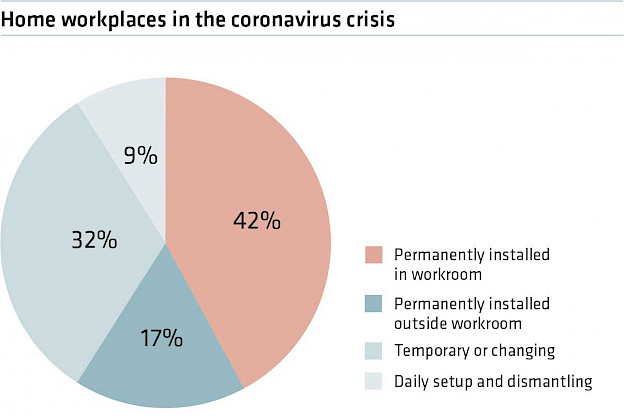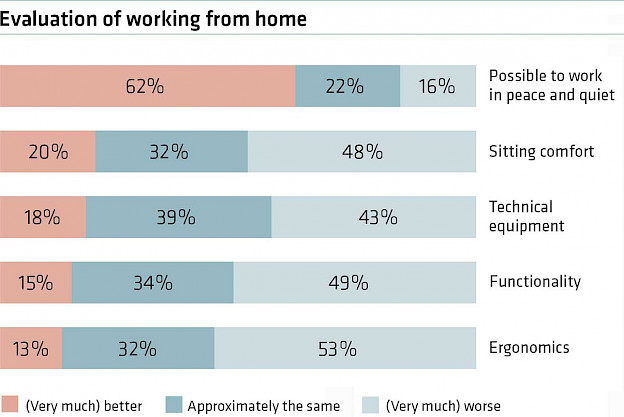During the Covid-19 lockdown in April 2020, 43% of employees were working from home more often than usual. The IBA conducted a survey to find out what advantages they experienced while working from home, what they missed and how they would like to work after the pandemic is over.
The results
Who was working from home?
At the end of April, half of the respondents (51%) were working from home every day. 14% worked from home four days a week, and 15% three days a week. A fifth of the employees (19%) worked from home for less than half of their working time. During the lockdown as well as before it, employees with a high level of formal education (EQF Level 4/university) were especially likely to work from home. Within this group, 57% worked from home every day. In addition, 57% of those employees who had children under the age of five in their household worked from home every day in April.
Where did people work?
42% of all those working from home had a separate room available for their work. 17% set up a permanent workstation for themselves in a living room or a bedroom. 9% had to set up and dismantle their work equipment every day. The worst working conditions were definitely experienced by the one third of employees (32%) who had no opportunity at all to set up a workstation. This situation most often affected employees under the age of 30. 41% of them improvised a workspace with a laptop on the kitchen table or on a sofa.


Equipment of the home workstations
When asked to rate the equipment of their workstations, most of the respondents emphasized that the opportunity to work in peace and quiet was a positive experience. 33% said this functions better at home, and 29% even said they could concentrate much better when working from home than at their workstation in the employer’s office. All the other aspects of the workstation design at home received worse, or even much worse, ratings by comparison to the employer’s office. 53% of the respondents said the ergonomics of their office setup at home left something to be desired—for example, because they did not have a separate monitor available to them or they had no opportunity to work standing up. 48% complained about the lack of a suitable swivel chair. Half of the respondents (49%) said the size of their work surface and the availability of storage space were insufficient. 43% of the respondents said the technical equipment of their workstation at home was inadequate.
A bit lonely
The respondents were asked to tell what else they missed while working from home. At 80%, the most frequently mentioned aspect was the contact with coworkers. Four out of ten home workers missed the teamwork and project work in the employer’s office, and 30% missed the personal contact with customers and business partners.
Spatial separation of work and leisure time
41% of the employees had difficulty keeping their professional work and private life separate. This especially affected the group of employees under 30 years of age (42%). Their older colleagues suffered from this problem much less often. But the biggest challenge was the (spatial) separation required by employees with children younger than five. Half of them (53%) complained that there was not enough separation between the two areas.
Wishes for the future
Lastly, the respondents had to say whether they wanted to continue working from home after the end of the pandemic. 41% said they would like to spend less time working from home than they were doing at the time of the survey in April 2020, but more time than they did before the pandemic. A fifth of the respondents (19%) said they would like to continue working from home as often as possible in the long term. A similar percentage (16%) said they would like to work from home just as often as they did before the pandemic. 21% of the respondents said they did not want to work from home any longer, or to do so only rarely, after the pandemic had tapered off. Older employees had a stronger desire than their younger colleagues to return to the employer’s office. A quarter of the employees between 45 and 59 years of age and 28% of the employees aged 60 or older did not want to work from home at all once the pandemic was over.
Summary
Many employees have come to appreciate working from home during the lockdown. Younger employees in particular give a positive rating to the increased flexibility working from home provides—even though many of them have to put up with worse working conditions than their older colleagues due to the available space. Nonetheless, working from home is not for everyone or for daily use. Companies will need to be very flexible and have the right degree of sensitivity in order to find the proportion of working from home that is right for them.
INFORMATION ON THE STUDY
forsa Politik- und Sozialforschung GmbH was commissioned by the IBA to conduct a survey from 21 to 28 April 2020 in which they asked dependent employees in Germany how they experienced working from home. The survey interviewed 1,000 individuals between the ages of 18 and 65 who worked from home more often during this period than before the pandemic. The respondents were chosen by means of a systematic random selection process. The forsa.omninet online panel was used for the survey.
_____
Photography in this article: Ridofranz / iStock by Getty Images




